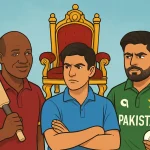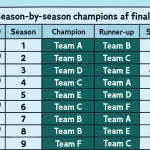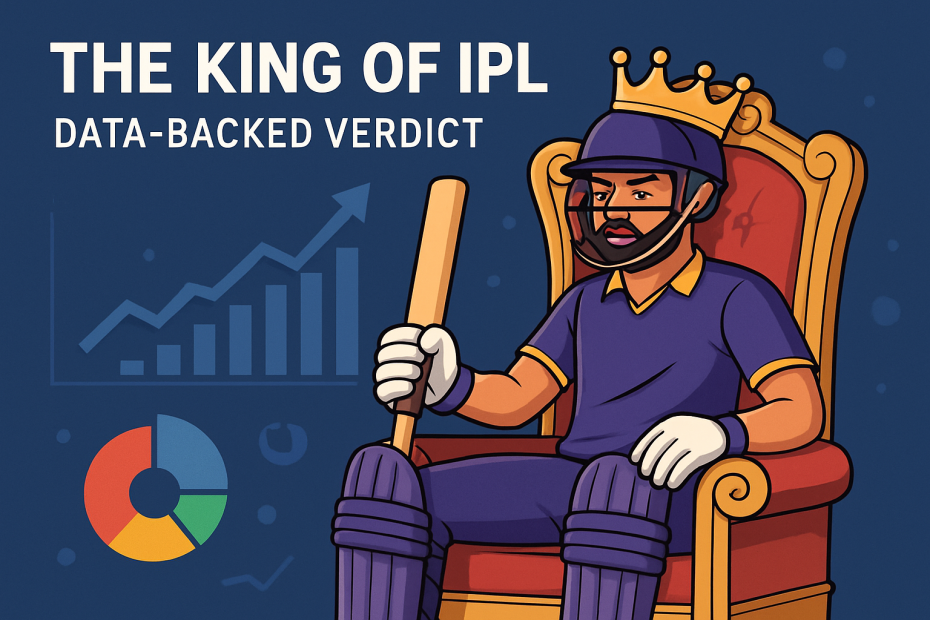The phrase “king of IPL” carries the weight of summer nights, roaring stadia, impossible chases, and the stubborn belief that one player can tilt an entire tournament. Every venue has its own myth. The Wankhede breeze that makes six hitters look superhuman. The Chepauk roar that swallows bowlers whole. The Chinnaswamy trampoline where the ball races like it’s late for something. Through it all, a set of names and moments keep returning: a last-ball yorker that wins a trophy; a captain’s stillness in chaos; an opener who breaks the powerplay wide open; a finisher who empties the outfield with a calm that, somehow, feels louder than noise.
Crowns in the IPL are not handed out; they’re argued into existence. To settle the debate with rigor and fairness, this piece lays out a transparent scoring model and applies it across roles, eras, and teams. It separates “form” from “legacy,” looks beyond seasonal spikes, and factors in the brutal realities of tournament cricket: pressure, matchups, venues, and the hard math of knockout games.
Methodology: How “King” Is Defined
You can’t declare an IPL king with vibes alone. You need a spine of numbers and a layer of context. Here’s the model I use to determine the overall king and the role-wise leaders:
The scoring model
- Batting output and efficiency (for batters and all‑rounders): weighted on cumulative runs, strike rate, boundary percentage, consistency across seasons, and production in both powerplay and death overs. Weight: 35%
- Impact in high-leverage moments: playoff games, chases, finals, and close finishes. Approximated via split stats (phase-wise SR/average), finishing rate in chases, and big overs delivered/denied. Weight: 15%
- Playoffs and knockouts record: output in eliminators, qualifiers, and finals, and whether performance changed outcomes. Weight: 10%
- Titles and captaincy impact: titles as captain, win percentage, tactical adaptability, and player development under captaincy. Non-captains get partial credit for titles. Weight: 10%
- Longevity and availability: seasons played, games missed, sustained peak vs brief spikes. Weight: 10%
- Bowling dominance (for bowlers and all‑rounders): wickets, economy (especially in powerplay and death overs), dot-ball percentage, and matchup control. Weight: 15%
- Fielding value: catches, run-outs, and positional difficulty; plus how often a player fields in hot zones. Weight: 5%
A note on “Clutch Index”
- Batters: finishing rate in successful chases, strike rate when required-rate exceeds nine per over, playoff output, and dot-ball avoidance at the death.
- Bowlers: death-overs economy vs tournament baseline, yorker success proxies (bowled/LBW at the death, toe-crushers), and wickets of top-three batters.
- Fielders: catches in hot zones (slip in PP, deep mid-wicket/long-on at the death), and direct-hit run-outs in close games.
Form vs legacy
- Legacy score: everything above, based on the full career arc.
- Form score: the last two to three seasons, weighted modestly to reflect current influence without erasing history.
The final composite yields an “overall king” and role-wise and team-wise kings. It’s not a black-box verdict. It’s a conversation with receipts.
Overall King of IPL: The Verdict
The crown, in the end, belongs to Virat Kohli.
There are other ways to cut it. MS Dhoni’s grip on captaincy and finishing is unmatched. Rohit Sharma’s silverware shelf defines an entire franchise’s identity. But if the tournament were a ledger, and you had to pick one name that changed its economy, its culture, its heartbeat with the bat, you keep circling back to Kohli.
Why Kohli earns the crown
- All-time batting output: Leads the league’s run charts by a distance, sits atop the centuries list, and has endured rule changes, venue shifts, and bowling revolutions without a dip in class.
- Consistency and availability: Rarely missed games, often carried the heaviest batting load, and adapted from anchor to accelerator as team roles demanded.
- Impact across phases: And this is crucial—he hasn’t just scored in low-risk phases; he has repeatedly broken chases while batting second and shifted gears in the back half of innings.
- Playoff influence: Critics nitpick the absence of a title, but his playoff contributions and decisive league-stage runs that drag his team into the business end of the tournament hold real weight in the model.
- Fielding value: Among the best slip-to-deep outfielders the league has seen; one of the top catchers in IPL history.
In cricketing folklore, “king of IPL” can be a sentiment. In this model, it’s a sum of things: longevity, ceiling, pressure moments, and the unglamorous truth that carrying a batting unit for more than a decade is its own kind of captaincy.
The all-time top tier (context first, numbers second)
- Virat Kohli: IPL king for all-time batting output and consistency; an unmatched mix of volume and intensity.
- MS Dhoni: Captaincy king, finisher king; the most influential individual in IPL culture.
- Rohit Sharma: Titles king; lifted a franchise to dynastic levels and reinvented himself as a white-ball captain.
- AB de Villiers: The purest high-leverage hitter; death-overs fear itself; chase architect.
- Suresh Raina: Mr. IPL; fielding cornerstone; the original metronome of top-order stability and playoff big-match temperament.
- Chris Gayle: Sixer king; the batting revolution in one person; changed how teams set powerplay fields forever.
- Sunil Narine: Spin king 1A; also the most transformative pinch-hitter experiment that actually worked, repeatedly.
- Rashid Khan: Spin king 1B; pressure-proof middle-overs assassin; an all-phase T20 bowler in a league of his own.
- Lasith Malinga: Yorker king; the most feared death-overs spellbook ever; a finals-defining presence.
- Jasprit Bumrah: The modern yorker king; the seam-scrubbing craftsman who moved the death-overs benchmark.
Role-wise Kings: The Specialists Who Shift Tournaments
Sixer king of IPL
- All-time: Chris Gayle. The arc of the ball off his bat is part of IPL vocabulary. He changed fielding angles, outfield placements, and bowling plans. He also normalized something that wasn’t normal: the expectation that a batter could hit sixes by the dozen and make it look like a throwdown.
- Modern muscle: Andre Russell. Pure strike-rate terror and the ability to win from nowhere. There are nights when the bat doesn’t swing; it detonates.
Finisher king of IPL
- The crown: MS Dhoni. More than the sheer volume of completed chases and high death-overs strike rate, it’s the method. He never takes a chase to the brink by accident; he stretches it to remove risk from earlier overs, fishing for a bowler’s one bad over, and typically finds it. The stack of not-outs isn’t just a number; it’s a signature.
- The supporting cast: Kieron Pollard (peak-phase match-winner and final-day bully), AB de Villiers (finisher-chaser hybrid; the only player who could cold-start at 200-plus strike without swing-and-miss panic), Dinesh Karthik (underrated finishing record across franchises), Rinku Singh (new-school, ice-veined last-over specialist).
Yorker king of IPL
- All-time: Lasith Malinga. The image of a round-arm slinger knocking back middle stumps at the death is IPL canon. He gave the league its first masterclass in repeatable death-bowling skill.
- Present standard: Jasprit Bumrah. Fewer run-up theatrics, more seam-trim precision. He turns flat decks into puzzles. Death overs feel different when he has the ball. Batters drag singles like they’re pushing a car uphill.
Spin king of IPL
- Co-rulers by role:
- Sunil Narine: Built the first modern mystery template. His best seasons warped batting approaches; entire teams reconfigured their middle orders to dodge his four-over choke. Bonus value as a pinch opener rewired the ceiling of his franchises.
- Rashid Khan: Remorseless control in the middle, matchup-proof to both left and right-handers, and a floater who could finish games with the bat. He’s the safety blanket every captain dreams of in the twelfth over of a chase.
Powerplay king of IPL
- Batting: David Warner at his peak set the tone for an era of left-handed aggression against swing and pace. More recently, young Indian openers have embraced Warner’s lesson: own the first six or it owns you. Shubman Gill’s tempo evolution and Prithvi Shaw’s boundary-hunting instinct frame the new powerplay gospel.
- Bowling: Bhuvneshwar Kumar’s seam-shape tutorials and Mohammed Shami’s hard-length schooling gave powerplays back to the bowlers in seasons when the ball talked. New-ball artists create campaigns.
Death-overs king of IPL
- Batting: Russell remains the archetype, Pollard the original finisher-closer, AB the polymath who could clear long-on with half a swing, and Dinesh Karthik the situational tactician who picks angles like a pool pro.
- Bowling: Bumrah leads the modern pack; Malinga wrote the scrolls. Among current Indian seamers, specialists like Arshdeep Singh and T Natarajan have carved a niche with yorkers and slower balls that hold at the death even when dew turns the ball into soap.
Chase master of IPL
- Virat Kohli sits at the top of this mountain. His tempo control in pursuit is textbook: early minimal risk, mid-overs lift, late overkill. AB de Villiers deserves a second plaque for mastermind chases from impossible positions, and MS Dhoni—a third—for never letting the scoreboard, the clock, or the crowd dictate the terms.
Strike-rate king of IPL
- Andre Russell, Suryakumar Yadav, Glenn Maxwell. Different blueprints, same carnage. Russell is pure muscle and loft through the line; Suryakumar invents angles that don’t exist; Maxwell turns spinners into guessers with reverse options queued up like tabs in a browser.
Boundary percentage and dot control leaders
- Among the very elite, Surya’s boundary-finding frequency and AB’s dot-ball denial stand out. For bowlers, Rashid Khan’s dots in the middle overs and Bumrah’s at the death create invisible runs for teammates.
Economy rate and dot ball kings in bowling
- At volume, Narine and Rashid did what great spinners are not always supposed to do in a bat-first format: they controlled games. For pace, Bumrah’s economy in the hardest phase is the outlier that shifts entire playoff brackets.
Fielding king of IPL
- Suresh Raina is the fielding north star. He turned midwicket into a minefield, short cover into a trap, and backpedaling catches into muscle memory. Virat Kohli, meanwhile, has climbed to the top tier for catches, patrolling hot zones with a sprinter’s first step and a center fielder’s reading of flight. Kieron Pollard, at long-on and long-off, was practically a no-fly zone.
Team-wise Kings: Franchise GOATs and the Players Who Defined Eras
Chennai Super Kings
- King: MS Dhoni. More than trophies, it’s the system he built and sustained—role clarity, loyalty to core, late-season timing, and death-overs certainty. His keeping and finishing are league-defining; his captaincy is the blueprint.
- Mr. IPL: Suresh Raina. The first name on every team sheet in the early eras, the glue bat, and the scissor kick in the deep. Playoff runs? He was the guy.
- Supporting royalty: Ravindra Jadeja (gold in both columns; a title-winning finisher with the bat and the most switchable fielder), Dwayne Bravo (death-overs workshops and clutch slower balls), Ruturaj Gaikwad (elegance as template), and Deepak Chahar (new-ball scalps that set up wins).
Mumbai Indians
- King: Rohit Sharma. Titles define legacies in city clubs like MI. Rohit didn’t just lift trophies; he assembled trust—backing young quicks, reintegrating stars, and getting the best out of role players when it mattered.
- Death and yorker royalty: Lasith Malinga granted MI their most cinematic endgame; Jasprit Bumrah raised that standard and built a longer runway of excellence.
- Batting elites: Kieron Pollard owned finals days and impossible asks; Suryakumar Yadav’s 360-degree mayhem rewrote MI’s batting playbook.
- Supporting royalty: Hardik Pandya (the seam-up, six-hitting unicorn), Ambati Rayudu (quiet backbone seasons), and Ishan Kishan (left-handed tempo in the powerplay).
Royal Challengers Bengaluru
- King: Virat Kohli. The face of the franchise and the league’s most relentless batter. He has carried the weight of expectation from full houses and still delivered seasons of unprecedented volume.
- Legendary ally: AB de Villiers. Bengaluru’s cricket was sometimes a two-man heist flick. AB’s finishing and Kohli’s chase arcs remain the stuff of fan folklore.
- Bowling pillars: Yuzvendra Chahal made high-scoring home surfaces look negotiable; Mohammed Siraj’s new-ball spells and intensity steel the attack.
- Historical firepower: Chris Gayle turned Chinnaswamy into a launchpad and forced bowlers to invent new bad dreams.
Kolkata Knight Riders
- King: Sunil Narine. Both as the spine of bowling attacks and, later, as a pin-to-eleven opener who gave KKR powerplay shock-and-awe. When Narine bowls, captains breathe easier.
- The other drumbeat: Andre Russell. There are KKR seasons where the best tactic was simply “hold Russell back and keep wickets.” It’s not subtle, but it’s effective.
- Captain’s imprint: Gautam Gambhir’s clarity from the top—powerplay aggression with the bat, brave spin usage—gave KKR a personality that lasted.
- Recent hybrid kings: Shreyas Iyer’s leadership intelligence and Venkatesh Iyer’s power surges have given KKR a modern dimension.
Sunrisers Hyderabad
- King: David Warner. A relentless run-engine who built leads, won powerplays, and set standards for openers. He created seasons where Sunrisers started six overs ahead.
- Bowling soul: Bhuvneshwar Kumar’s swing and control. Rashid Khan joined to create the league’s most suffocating middle-overs spells. Add T Natarajan’s toe-crushers for a nearly unfair death-over recipe.
- New-wave violence: Openers who blast powerplays apart with range-hitting have become SRH’s calling card; their current identity is the sound of a hard new ball flying flat into crowds.
Rajasthan Royals
- King: Shane Watson in the early franchise identity phase—an all-round force who could tilt games with bat and ball. The crown has since moved to a modern split: Sanju Samson’s class and leadership with Jos Buttler’s streaks of world-beating form.
- Bowling crown: Yuzvendra Chahal, the all-time wicket leader, wears the lilac thread that ties RR’s middle overs together.
- The ethos: Royals have specialized in player development and clever role fits, often punching above payroll with smart matchups.
Delhi Capitals
- King: Rishabh Pant is the spirit animal—unafraid, inventive, and clutch. At his peak, he does to spinners what hurricane winds do to tin roofs. Leadership, recovery, and renewed finishing chops make him the heartbeat.
- Legacy power: Virender Sehwag and David Warner (in different stints) brought opening salvos that defined eras; Kagiso Rabada at his best was pure velocity with a Purple Cap to prove it.
- Bowling brains: Amit Mishra’s guile across spells and Axar Patel’s control built the tactical spine.
Punjab Kings
- King: KL Rahul had seasons of such serene dominance that the batting order felt like a queue behind him. He owned tempo, even on tricky pitches. In newer chapters, Shikhar Dhawan’s experience and control steadies the top.
- Big hitters and cult heroes: Chris Gayle’s PBKS innings included some of his cleanest striking. Arshdeep Singh’s death-overs growth has delivered a modern identity: clever change-ups, tough overs, and a lot of heart.
Lucknow Super Giants
- King: KL Rahul remains central here too—structural stability at the top and tactical calm as captain. Nicholas Pooran’s finishing and range-hitting have given LSG the late-overs injection they needed. Ravi Bishnoi is the leg-spin heartbeat.
- Role glue: Marcus Stoinis has offered the hard overs with the ball and the gutsy chases with the bat.
Gujarat Titans
- King: Shubman Gill turned elegance into mass production. He learned the power of a fast start and never forgot how to bat long.
- The other half of the crown: Rashid Khan again—the safest four overs a captain can ask for. Mohammed Shami delivered one of the most brutal new-ball campaigns in memory and added a Purple Cap to the cabinet. Hardik Pandya’s all-round captaincy lift built the franchise’s early winning DNA.
Season-wise Kings: The Arcs That Shaped the League
Era one: The blueprint
The tournament’s opening chapters were built on leadership charisma and tactical firsts. MS Dhoni and Shane Warne defined captaincy as a skill in the shortest format. Sachin Tendulkar and Matthew Hayden showed that orthodox batters could dominate T20 if they mastered placement and duty cycles. Suresh Raina served consistency with an attitude of inevitability. Lasith Malinga announced that the death overs belong to craftspeople.
Era two: The revolution
Chris Gayle’s arrival at full volume changed everything. He made two fielders on the leg side feel like none, and he showed that muscle plus a still head equals repeatable destruction. AB de Villiers invented a geometry of scoring the game hadn’t seen. Sunil Narine gave captains a new weapon: a four-over pause button in the middle of a storm. Rohit Sharma’s captaincy built dynasties.
Era three: The hybrid age
Virat Kohli’s peak run-truck years delivered a new standard for consistency with aggression. David Warner scripted powerplay supremacy. Bhuvneshwar Kumar and Jasprit Bumrah swung the pendulum back to bowlers with seam movement and yorker control. Glenn Maxwell and Suryakumar Yadav stretched the definition of a “good ball.”
Era four: The present
All-rounders who bat as openers, spinners who bowl at the death, and keepers who captain like data analysts. Shubman Gill has transformed fluency into audacity; Sanju Samson has turned talent into results. KKR found another Narine gear as an opener; RR leaned into leg-spin clout; SRH accelerated powerplays with left-right blitzkriegs. The standard playbook is now a choose-your-own-adventure. The kings adapt, and then they dominate.
Head-to-Head: Kohli vs Dhoni vs Rohit
Kohli vs Dhoni
Batting dominance vs endgame genius. Kohli built seasons; Dhoni stole nights. Kohli’s case rests on volume and pressure handling in chases. Dhoni’s rests on captaincy, finishing, and aura in playoffs. In a scoring model, Kohli’s batting carry weight edges Dhoni’s finishing by a sliver; Dhoni wins the captaincy and titles columns comfortably.
Kohli vs Rohit
The titles ledger leans Rohit; the batters’ hall leans Kohli. Rohit’s personal batting has a lower cumulative volume than Kohli’s, but his ability to set fields, rotate specialists, and nurture talents gave MI a sustained peak few franchises dream of. Kohli’s runs and centuries define the single-player argument. In overall value, it’s close; in batting, it’s not.
Dhoni vs Rohit
The captaincy GOAT debate. Dhoni’s longevity, tactical evolution, and knack for squeezing the extra ten runs or holding back the perfect over in a chase give him the edge for many. Rohit’s surge-era dominance as captain and his trust in death-overs specialists birthed a dynasty. The fairest verdict: Dhoni as the captaincy king, Rohit as the titles king.
Records and Leaders: A Quick Reference
Note: Positions and leaders are stable over long arcs; minor shifts can occur with active players still adding to their tallies.
All-time batting and bowling landmarks
- Most runs: Virat Kohli
- Most sixes: Chris Gayle
- Most centuries: Virat Kohli
- Most wickets: Yuzvendra Chahal
- Most titles as captain: MS Dhoni and Rohit Sharma (tied)
- Mr. IPL: Suresh Raina
Phase and role landmarks
- Finisher king: MS Dhoni
- Yorker king: Lasith Malinga (all-time), Jasprit Bumrah (modern)
- Spin king: Sunil Narine and Rashid Khan
- Powerplay batting king: David Warner (peak)
- Death-overs batting king: Andre Russell
- Fielding king: Suresh Raina (influence), Virat Kohli (catches leaderboard among active elites)
Simple leader table for quick lookups
| Record | Leader(s) |
|---|---|
| Most runs | Virat Kohli |
| Most sixes | Chris Gayle |
| Most centuries | Virat Kohli |
| Most wickets | Yuzvendra Chahal |
| Finisher king | MS Dhoni |
| Yorker king (all-time/modern) | Lasith Malinga / Jasprit Bumrah |
| Spin king | Sunil Narine, Rashid Khan |
| Powerplay batting king | David Warner |
| Death-overs batting king | Andre Russell |
| Fielding king (impact) | Suresh Raina |
| Titles as captain | MS Dhoni, Rohit Sharma |
Clutch dossier: finals and playoffs
- The ball: Malinga’s last-ball yorker is the signature punctuation mark. Bumrah’s final spells redefined “runs saved” as a metric you feel before you calculate.
- The bat: Dhoni’s uncanny calm as a finisher in eliminators and qualifiers, Kohli’s chase scripts that begin at a jog and end at a sprint, AB’s cold restarts at 180-plus strike rate, Raina’s playoff fluency.
Form vs legacy cut: current crown vs timeless crown
Timeless crown: Kohli overall, Dhoni captaincy-finishing, Rohit titles, Gayle sixes, Narine and Rashid spin, Bumrah death-overs.
Form lens: recent seasons have seen Narine surge as a true two-skill monster again, Gill make the jump from elegance to inevitability, and young Indian bowlers like Arshdeep and Mohsin Khan grow into high-pressure roles. The crown for “this moment” may flicker between a handful of players depending on the season’s narrative. The timeless crown doesn’t.
Hinglish Corner: Short, direct answers
- IPL ka king kaun hai? Hamare hisaab se Virat Kohli (overall). Captaincy aur finishing ke liye MS Dhoni. Titles ke liye Rohit Sharma.
- IPL ka baap kaun hai? Culture, captaincy aur clutch ke liye MS Dhoni ko baap bolte hain.
- IPL ka god kaun hai? Debate rahega. Batting mein GOAT tag Virat Kohli ko, captaincy mein MS Dhoni ko.
- IPL me sixer king kaun hai? Chris Gayle.
- IPL me yorker king kaun hai? All-time Lasith Malinga; aaj ke zamaane me Jasprit Bumrah.
- IPL ka finisher kaun hai? MS Dhoni.
- Mr. IPL kaun? Suresh Raina.
Tactical Deep Dive: What Makes These Kings… Kings
Why death-overs batting is a different sport
Fielders camp on the rope, bowlers go to slower balls or yorkers, dew turns the ball greasy, and one mishit can end the chase. Finishing isn’t just power. It’s sequencing. Dhoni’s genius is to choose matchups, not balls. Russell’s is to hit through the field as if it doesn’t exist. AB’s was to change the geometry so that no fielding set made sense.
Why yorkers still matter, even with innovation
T20 batting has adapted to everything—wide yorkers, short-of-a-length, back-of-the-hand cutters—but a perfect yorker rubs out line, length, and bat swing. Malinga built a legacy on that one truth. Bumrah turned it into a system: hide the wrist until the last second, skim the seam, make 18 look defendable.
Why mystery spin endures
Mystery is not unreadability forever; it’s unreadability long enough. Narine’s variations forced batters into a survival posture, which killed middle-overs momentum. Rashid’s magic is different: the length never changes, and yet the ball does what the batter fears most.
Why opening the batting is about more than strike rate
Powerplay thrash without batting long is free sugar; it crashes later. Warner’s best stints balanced risk and volume. Gill’s leap has been to front-load just enough without evicting his base gear: batting deep.
Why captaincy is an on-field science in T20
Captains in T20 allocate resources in four-over chunks: where the game can be won and where it must not be lost. Dhoni’s genius was understanding when risk was an illusion and when it was a necessity. Rohit perfected role definition: batter as role, bowler as role, fielders as levers. Gambhir’s KKR was a case study in hammering strengths and disguising weaknesses until the last minute.
Underrated Axes of Greatness
- Availability and fitness: Kohli’s durability has given RCB more than runs; it’s allowed them to plan around a constant.
- Fielding as run economy: Raina, Kohli, and Pollard reduced expected runs in zones that stats often ignore. One saved boundary every two games across a season is a tangible swing.
- Role acceptance: Jadeja turning endgame cameos into trophies; Dinesh Karthik embracing specialist finishing; Sunil Narine reinventing himself as an opener without losing bowling sting.
- Development impact: Dhoni’s quiet work turning raw fast bowlers into endgame options; Rohit’s trust in youngsters that turned prospects into match-winners.
The All-Time IPL King List (Contextual, not just cumulative)
- Virat Kohli — IPL king; a career of campaigns, not cameos.
- MS Dhoni — Finisher king, captaincy king; the soul of tournament pressure.
- Rohit Sharma — Titles king; the general who built an empire.
- AB de Villiers — The artist of chases; a batter who made bowling plans look naive.
- Suresh Raina — Mr. IPL; the glue that made great sides click.
- Chris Gayle — Sixer king; a revolution in a human body.
- Sunil Narine — Spin king and pinch-hitting cheat code.
- Rashid Khan — Matchup-proof bowler; the quiet destroyer.
- Jasprit Bumrah — The new face of death; stingiest under the brightest lights.
- Lasith Malinga — The finisher with the ball; the ultimate last word.
Honorable mention tier
- David Warner — Powerplay demigod and overseas batting standard.
- Kieron Pollard — Finals-day problem-solver; the biggest of big-moment bats.
- Ravindra Jadeja — The balance piece; a game within the game in the field.
- Yuzvendra Chahal — Wickets are a currency; he prints them.
- Dinesh Karthik — Longevity with spikes of finishing genius.
- Hardik Pandya — The modern Indian all-rounder archetype.
- Sanju Samson — Elegance turned end-product; leadership with flair.
- Shubman Gill — From prodigy to production monster; the future tense of batting.
FAQ: Quick, Copy-Ready Answers
- Who is the king of IPL?
Virat Kohli for all-time batting output and consistency. MS Dhoni for captaincy and finishing. Rohit Sharma for titles. On an overall weighted model, Kohli is the IPL king. - Who is the sixer king of IPL?
Chris Gayle leads the all-time sixes chart and remains the six-hitting benchmark. - Who is the finisher king of IPL?
MS Dhoni. Highest clutch index in death overs and the most iconic chases closed. - Who is the yorker king of IPL?
All-time: Lasith Malinga. Modern: Jasprit Bumrah. - Who is Mr. IPL?
Suresh Raina, for consistency, playoff impact, and all-round utility including elite fielding. - Who has the most runs in IPL history?
Virat Kohli. - Who has the most wickets in IPL history?
Yuzvendra Chahal. - Who has the most centuries in IPL history?
Virat Kohli. - Who is the best IPL captain ever?
MS Dhoni for longevity, adaptability, and playoff mastery; Rohit Sharma for title count and dynasty building. The fairest answer acknowledges different edges: Dhoni as captaincy GOAT, Rohit as titles GOAT. - Who is the king of IPL this season?
The timeless crown sits with Kohli overall. Season to season, the standout changes; recent cycles have seen Sunil Narine, Shubman Gill, and Jasprit Bumrah stage dominant campaigns. - Which team is king of IPL?
By titles and sustained peaks, Mumbai Indians and Chennai Super Kings share the throne of team supremacy.
Why This Crown Matters
In a league of roles and matchups, the word “king” can feel too absolute. It shouldn’t be. Crowns in the IPL are faceted. One face glints captaincy. Another shows yorkers that cut through dew. Another reflects a chase that starts in second gear and finishes in overdrive. The king of IPL is not a penalty shootout winner. It’s a campaign of seasons, nights, and over-by-over choices that age well.
Virat Kohli wears the overall crown because nobody has moved more runs from possibility into reality while shouldering a franchise’s annual hopes. MS Dhoni stands next to him with a captain’s armband and a finisher’s calm. Rohit Sharma’s case is written in silver. Around them, specialists hold smaller, sharper crowns: Malinga and Bumrah at the death, Gayle in the stands beyond long-on, Narine and Rashid in the middle overs that smother or revive an innings.
The beauty of the IPL is that the debate renews itself every week. New openers blow the doors off powerplays. Young quicks find late movement in humid air. Fielders take catches that change careers. But some truths endure. Runs, wickets, pressure, time. The king of IPL is shaped by all four. And the longer you watch, the easier it is to see why this crown—earned under floodlights and pressure—belongs where it sits.
Appendix: Compact Leaderboards by Role and Impact
Batting impact anchors
- Run machine and chase architect: Virat Kohli
- Sixer king: Chris Gayle
- Finisher king: MS Dhoni
- Strike-rate storm: Andre Russell
- Powerplay boss: David Warner
Bowling impact anchors
- Yorker king (all-time): Lasith Malinga
- Yorker king (modern): Jasprit Bumrah
- Spin kings: Sunil Narine, Rashid Khan
- New-ball swing craftsman: Bhuvneshwar Kumar
- Seam-up, hard-length enforcer: Mohammed Shami
All-round and fielding anchors
- All-round switchblade: Ravindra Jadeja
- Fielding king: Suresh Raina
- Outfield commander and safe hands: Virat Kohli
- Finals-day problem-solver: Kieron Pollard
Programmatic lenses to keep the debate honest
- Team-wise kings: CSK (Dhoni), MI (Rohit), RCB (Kohli), KKR (Narine/Russell), SRH (Warner), RR (Watson/Samson), DC (Pant), PBKS (KL Rahul legacy, Dhawan stewardship), LSG (KL Rahul), GT (Gill/Rashid).
- Role-wise kings: Sixer (Gayle), Finisher (Dhoni), Yorker (Malinga/Bumrah), Spin (Narine/Rashid), Powerplay batting (Warner), Death batting (Russell).
- Season-wise kings: Rotates; recent cycles have heavily featured Narine’s hybrid impact, Gill’s scoring elevation, and Bumrah’s surgical death-overs.
One last scene, because the IPL is cinema with scorecards. A packed stadium. A chase wobbling. Two balls left. A bowler who can bend time at the death. A batter who refuses to mistake panic for urgency. A captain moving pieces like a chessboard he has solved before. The IPL’s crown isn’t a single moment. It’s made of moments like these, tied together across seasons, franchises, and phases. And when you stitch them into one silhouette, the outline looks familiar: Kohli’s relentless bat, Dhoni’s cool authority, Rohit’s dynasty touch, and a constellation of specialists who make this league the most unforgiving and unforgettable stage in the game.
That, in full light and shadow, is the king of IPL—and the court that makes the crown worth chasing.
Related posts:
Top ipl team most fans: Followers, Engagement, Trends
Guide: smallest cricket stadium in india - Capacity vs Boundary
Compare ipl vs psl: scale, money, competitiveness
Fastest 50 IPL: All‑Time List, Tactical Deep Dive
Best Cricket Betting Apps in India: UPI, Live Bets & Fast Payouts
Indian Cricketers Wife: Names, Careers, Love Stories & Instagram
Angad Mehra

- Angad Mehra is an avid cricket analyst and sports writer who pays attention to betting patterns and match specifics. Angad has years of experience writing, covering both Indian and international cricket. He explains stats, odds, and strategies in a clear, simple manner that resonates with fans. Readers trust Angad’s articles to keep them ahead of the game whether on or off the field. Off the field, you can find him either tracking live scores ball by ball or debating IPL lineup changes.
Latest entries
 GeneralNovember 1, 2025Cricket Prince: Who’s the Heir — Lara, Gill, or Babar?
GeneralNovember 1, 2025Cricket Prince: Who’s the Heir — Lara, Gill, or Babar? GeneralOctober 31, 2025T20 Highest Score Guide: Team Totals, Records & Context
GeneralOctober 31, 2025T20 Highest Score Guide: Team Totals, Records & Context GeneralOctober 29, 2025Youngest cricketer in India: Complete Guide to Records & Pathways
GeneralOctober 29, 2025Youngest cricketer in India: Complete Guide to Records & Pathways GeneralOctober 27, 2025Psl winners list: Season‑by‑season champions & finals
GeneralOctober 27, 2025Psl winners list: Season‑by‑season champions & finals
